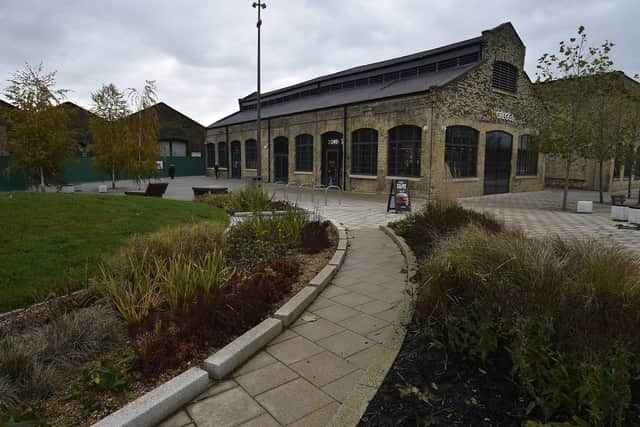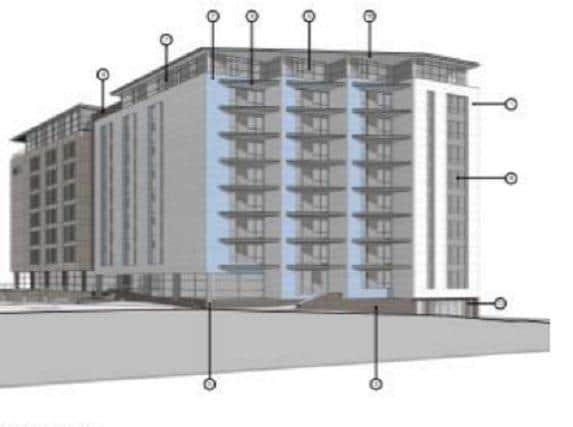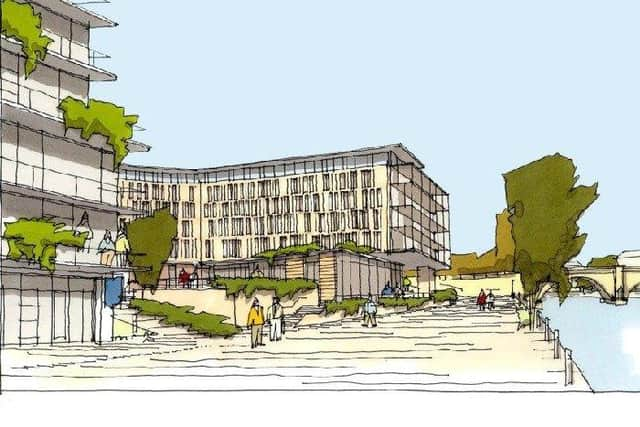Will new-look Fletton Quays development in Peterborough be a success?
and live on Freeview channel 276
In 2015 planning permission was granted for a £120 million redevelopment of Fletton Quays – overlooking the River Nene near the Embankment – which earmarked the site for 265 high end apartments, restaurants, a 160-bed hotel and two blocks of offices.
Since then much has changed, with the number of planned apartments already surpassing 450 and set to rise higher after funding for a new arts centre never materialised, meaning the former Whitworth Mill will now also become housing.
Advertisement
Hide AdAdvertisement
Hide AdPeterborough City Council has also moved into its brand new Sand Martin House offices on the site, where soon it will be joined by 1,000 government workers.


The hotel, we now know, will be a Hilton Garden Inn, while there will also be a whisky and gin distillery and an ‘urban beach’.
Advertisement
Hide AdAdvertisement
Hide AdMembers of the Conservative administration have trumpeted their efforts in finally getting the site developed, as well as the money it will make from council tax and business rates.


But the Peterborough Civic Society – which opposed the plans in 2015 – believes little has changed since to make them alter its view.
Joint planning group leader Kem Mehmed said: “The main word then was ‘disappointment’. We’ve waited 30 years for the South Bank to be developed with the reason for the delay to try and get a flagship thing to put Peterborough on the map – something cultural, leisure or entertainment. It’s a wonderful site by the river and we wanted something to enhance public facilities, but now we’ve ended up with something with very little attraction.
“There are a large number of properties at a much greater density than necessary which are pretty poorly served by public transport. So far there’s no footbridge to link it with the Embankment, and there’s no quayside at Fletton Quays.
Advertisement
Hide AdAdvertisement
Hide Ad“All in all, after decades of waiting, we’ve got a scheme that could have been implemented in five years.


“It’s not difficult to get developers to put money into something profitable like houses. And none of it is affordable, while the hotel architecturally won’t do much for the city.”
Fletton Quays is being overseen by the Peterborough Investment Partnership, a joint venture between the council and the Lucent Strategic Land Fund.
Asked for his thoughts on how the scheme was developing, council leader Cllr John Holdich said: “Our vision for Fletton Quays was to kickstart a development that would further boost the city’s economy, create a new age of tourism and extend the city centre to the south, creating hundreds of new jobs and housing.
Advertisement
Hide AdAdvertisement
Hide Ad“We are well on the way to achieving that and the development is progressing well.
“This important city centre site was under-used for decades and was in danger of becoming a permanent wasteland until the council, together with Peterborough Investment Partnership, took ownership and spearheaded its transformation.
“Many cities are struggling economically, but we’re really proud to say that our future growth is bright.”
A spokesperson for the Peterborough Investment Partnership said: “We’re pleased with how the site is progressing at Fletton Quays.
Advertisement
Hide AdAdvertisement
Hide Ad“This is a complex site with a unique combination of constraints, but already we’ve seen the development of the biggest office site in the city centre’s recent history at Sand Martin House, a number of high-quality apartments home the site’s first residents, and the recent government announcement will bring one of the country’s few regional government hubs to the city.
“This is alongside the Hilton hotel and sky bar – coming forward soon– as well as the distillery and other retail and leisure outlets still to be announced.
“All in all, we’re very excited about what the next year holds.”
Will traffic system be able to cope?
Peterborough City Council said it is confident the three-way traffic system by the Fletton Quays development will be sufficient, despite a large rise in the number of planned apartments and workers at the site than had originally been envisaged.
Advertisement
Hide AdAdvertisement
Hide AdThe number of proposed apartments has risen from 265 to more than 450, and that is still set to increase further, while 1,000 government workers will join council staff on the site.
A council spokesperson said: “We are including extra homes on the site but are confident that the three way traffic system at the entrance is suitable for the number of homes that will be on site.
“In addition, we are always exploring schemes that could improve vehicle, pedestrian and cycling access and this will continue in future years.
“City centre living is a core part of our climate change strategy as those who live in city centres are less reliant on vehicles.”
Advertisement
Hide AdAdvertisement
Hide AdBut Matthew Barber, head of partnerships (Midlands and East) for sustainable transport charity Sustrans, said: “There have definitely been missed opportunities with Fletton Quays – for such an important development, discussed for decades, it’s actually really difficult to access the site by foot or by bike.
“For instance, leaving East Station Road and heading towards Oundle Road, as a pedestrian you are required to cross seven signalised crossings just to make a 200m trip.
“Likewise for cyclists, the provided infrastructure is limited and confusing.
“Unfortunately, until we start designing access which prioritises pedestrians and cyclists, providing them with safe, coherent and continuous infrastructure, the default will be for people to drive.”